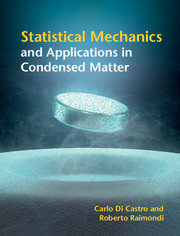Book contents
- Frontmatter
- Contents
- Preface
- 1 Thermodynamics: a brief overview
- 2 Kinetics
- 3 From Boltzmann to Boltzmann–Gibbs
- 4 More ensembles
- 5 The thermodynamic limit and its thermodynamic stability
- 6 Density matrix and quantum statistical mechanics
- 7 The quantum gases
- 8 Mean-field theories and critical phenomena
- 9 Second quantization and the Hartree–Fock approximation
- 10 Linear response and the fluctuation–dissipation theorem in quantum systems: equilibrium and small deviations
- 11 Brownian motion and transport in disordered systems
- 12 Fermi liquids
- 13 The Landau theory of second order phase transitions
- 14 The Landau–Wilson model for critical phenomena
- 15 Superfluidity and superconductivity
- 16 Scaling theory
- 17 The renormalization group approach
- 18 Thermal Green functions
- 19 The microscopic foundations of Fermi liquids
- 20 The Luttinger liquid
- 21 Quantum interference effects in disordered electron systems
- Appendix A The central limit theorem
- Appendix B Some useful properties of the Euler Gamma function
- Appendix C Proof of the second theorem of Yang and Lee
- Appendix D The most probable distribution for the quantum gases
- Appendix E Fermi–Dirac and Bose–Einstein integrals
- Appendix F The Fermi gas in a uniform magnetic field: Landau diamagnetism
- Appendix G Ising and gas-lattice models
- Appendix H Sum over discrete Matsubara frequencies
- Appendix I Two-fluid hydrodynamics: a few hints
- Appendix J The Cooper problem in the theory of superconductivity
- Appendix K Superconductive fluctuation phenomena
- Appendix L Diagrammatic aspects of the exact solution of the Tomonaga–Luttinger model
- Appendix M Details on the theory of the disordered Fermi liquid
- Appendix N Answers to problems
- References
- Index
20 - The Luttinger liquid
Published online by Cambridge University Press: 05 September 2015
- Frontmatter
- Contents
- Preface
- 1 Thermodynamics: a brief overview
- 2 Kinetics
- 3 From Boltzmann to Boltzmann–Gibbs
- 4 More ensembles
- 5 The thermodynamic limit and its thermodynamic stability
- 6 Density matrix and quantum statistical mechanics
- 7 The quantum gases
- 8 Mean-field theories and critical phenomena
- 9 Second quantization and the Hartree–Fock approximation
- 10 Linear response and the fluctuation–dissipation theorem in quantum systems: equilibrium and small deviations
- 11 Brownian motion and transport in disordered systems
- 12 Fermi liquids
- 13 The Landau theory of second order phase transitions
- 14 The Landau–Wilson model for critical phenomena
- 15 Superfluidity and superconductivity
- 16 Scaling theory
- 17 The renormalization group approach
- 18 Thermal Green functions
- 19 The microscopic foundations of Fermi liquids
- 20 The Luttinger liquid
- 21 Quantum interference effects in disordered electron systems
- Appendix A The central limit theorem
- Appendix B Some useful properties of the Euler Gamma function
- Appendix C Proof of the second theorem of Yang and Lee
- Appendix D The most probable distribution for the quantum gases
- Appendix E Fermi–Dirac and Bose–Einstein integrals
- Appendix F The Fermi gas in a uniform magnetic field: Landau diamagnetism
- Appendix G Ising and gas-lattice models
- Appendix H Sum over discrete Matsubara frequencies
- Appendix I Two-fluid hydrodynamics: a few hints
- Appendix J The Cooper problem in the theory of superconductivity
- Appendix K Superconductive fluctuation phenomena
- Appendix L Diagrammatic aspects of the exact solution of the Tomonaga–Luttinger model
- Appendix M Details on the theory of the disordered Fermi liquid
- Appendix N Answers to problems
- References
- Index
Summary
For pure fermionic systems, and in the absence of symmetry breaking (e.g. magnetism, superconductivity, …), two types of metallic phases are well established: (i) the “normal” Fermi liquid phase in d = 3 presented in Chapters 12 and 19 via the response and the Green functions techniques; and (ii) the “anomalous” Luttinger liquid phase in d = 1 originally formulated with the bosonization technique by which the fermionic operators are represented in terms of “bosonic” density operators (Luther and Peschel (1974); Haldane (1981)) with the exact solution (Mattis and Lieb (1965)) of the Tomonaga–Luttinger model (Tomonaga (1950); Luttinger (1963)) discussed inmany reviews and books (see for instance the book by Giamarchi (2004)).
Here, to stress similarities and differences between the Fermi liquid and the Luttinger liquid, we will follow the alternative route of response and Green functions techniques (Dzyaloshinskii and Larkin (1973), Di Castro and Metzner (1991), Metzner et al. (1998)) and add a few comments on the renormalization group approach (Metzner and Di Castro (1993)).
As we have seen in Chapters 12 and 19, the Fermi liquid is described asymptotically by the free low-lying single-particle excitations, i.e., the quasiparticles with a zero-kelvin discontinuous occupation number in momentum space nk (see Eq. (18.54)) at a well defined Fermi surface (k = k F):
where here k F> and k F< indicate the limit k → kF from above and below. This discontinuity still marks the Fermi surface in the interacting system. The finite reduction of the single-particle spectral weight zkF with respect to the Fermi gas (zkF = 1) is given by the finite (i.e. non-critical) “wavefunction renormalization” (see Eq. (18.94)). The presence of the discontinuity at the Fermi surface, together with the Pauli principle, compel the inverse quasiparticle lifetime to be τ−1 ≈ max(T2, ϵ2), where _ is the deviation of the energy of the quasiparticle from the Fermi energy. The energy uncertainty ħτ−1 due to the finite lifetime of a quasiparticle near the Fermi surface is small compared to its energy ϵ, and the quasiparticle concept is well defined. All the momentum transferring scattering processes become asymptotically ineffective, as derived phenomenologically in Chapter 12 and confirmed microscopically in Chapter 19.
- Type
- Chapter
- Information
- Statistical Mechanics and Applications in Condensed Matter , pp. 358 - 374Publisher: Cambridge University PressPrint publication year: 2015



